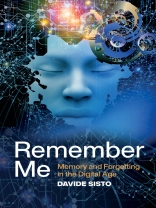As the end of December draws near, Facebook routinely sends users a short video entitled ‘Your Year on Facebook’. It lasts about a minute and brings together the images and posts that received the highest number of comments and likes over the last year. The video is rounded off with a message from Facebook that reads: ‘Sometimes, looking back helps us remember what matters most. Thanks for being here.’
It is this ‘looking back’, increasingly the focus of social networks, that is the inspiration behind Davide Sisto’s brilliant reflection on how our relationship with remembering and forgetting is changing in the digital era. The past does not really exist: it is only a story we tell ourselves. But what happens when we tell this story not only to ourselves but also to our followers, when it is recorded not only on our social media pages but also on the pages of hundreds or thousands of others, making it something that can be viewed and referenced forever? Social media networks are becoming vast digital archives in which the past merges seamlessly with the present, slowly erasing our capacity to forget. And yet at the same time, our memory is being outsourced to systems that we don’t control and that could become obsolete at any time, cutting us off from our memories and risking total oblivion.
This timely and thoughtful reflection on memory and forgetting in the digital age will be of interest to students and scholars in media studies and to anyone concerned with the ways our social and personal lives are changing in a world increasingly shaped by social media and the internet.
Tabla de materias
Table of contents:Acknowledgements
Introduction. Social Networks and Looking Back
The past is just a story we tell our followers
Facebook and Looking Back: #10Years Challenge, On This Day, Memories
Chapter One. From Social Networks to Digital Archives
The Twenty Days of Turin: Facebook in 1977
Naked in front of the Computer: Social Networks in the 1990s
The World Doubled: Reincarnation or the Cocaine of the Future?
Blogs, Forums, Mailing Lists: A New Life in 56K
The Era of Shared Passions: An Epidemic of Digital Memories
Digital Memory as Crazed Mayonnaise: The Past is Emancipated, Identities Multiply
Chapter Two. Collective Cultural Autobiographies and Encyclopedias of the Dead 2.0
Experiments in Collective Cultural Autobiography
Copy and Paste: Writing About Oneself is Like Summing Up the History of the Universe
Cancer Bloggers: My Message is My Body
Stories of Cancer Bloggers on You Tube and Facebook
Facebook: Encyclopedia of the Dead 2.0?
Autobiographical Memory: Inventing a Forgotten Past
Disinterred Bodies: Social Networks and Data Flows as Archives
Chapter Three. Total Recall, Digital Immortality, Retromania
Becoming the Database of Ourselves: Lifelogging and Video-camera Memory
The Memobile: From Total Recall to Digital Immortality
The Memory Remains: The Life of Memories Post-Mortem
Mind-Uploading as a Declaration of Independence for Memories
Insomnia Inside a Garbage Heap: Funes, or of a Life that Never Forgets
Creating Space in Memory: Forgetting and Sleep as Forms of Resistance
The Web as a Melancholy Receptacle of Regret: Hollie Gazzard, The Last Message Received, Wartherapy
Retromania and Sad Passions: The End of Nostalgia and the Loss of the Future
San Junipero Exists and Lives in Facebook
Conclusion. Digital Inheritance and a Return to Oblivion
Digital Inheritance: What to Do with our Own Memories?
The Value of Oblivion and the Joy of Being Forgotten
Bibliography
Notes
Index
Sobre el autor
Davide Sisto is a researcher in Theoretical Philosophy at the University of Turin.












